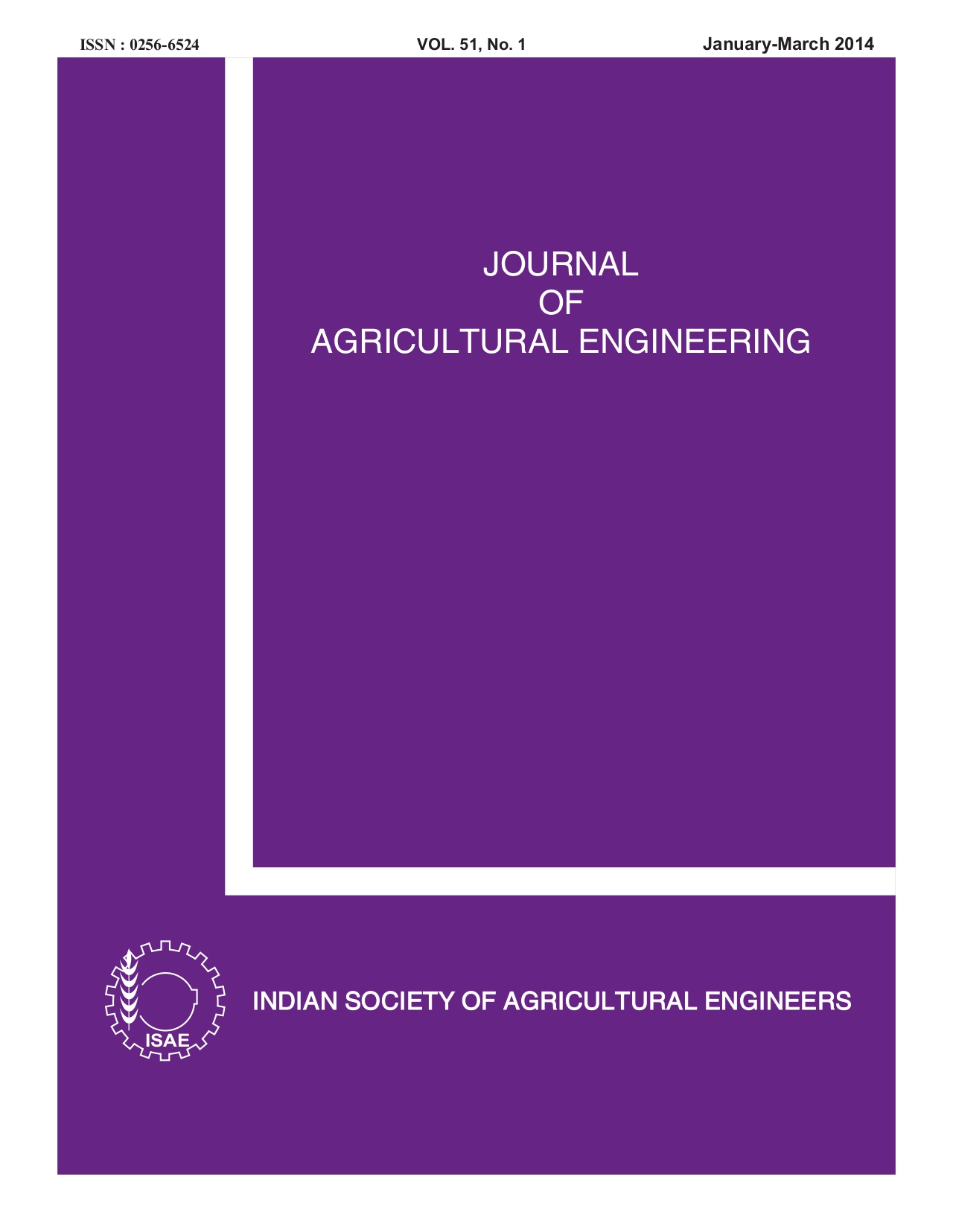Water Absorption Kinetics of Pearl Millet Grains
DOI:
https://doi.org/10.52151/jae2014511.1539Keywords:
Pearl millet, water absorption kinetics, activation energy, diffusivityAbstract
Water absorption characteristics of pearl millet (PC 443) were evaluated in the temperature range of ambient (16°C) to 100°C. Water absorption by the grain increased with increase in temperature. The increase in water absorption by the grain was more rapid at temperatures 70°C and above. The initial rates of hydration at temperatures 16, 30, 40, 50, 60, 70, 80, 90 and 100°C were 14.2, 20.5, 24, 32.9, 43.2, 47.6, 94.7, 136.3, and 142.7 g.kg.dm-1.min-1, respectively. The rate of hydration decreased with increase in hydration time and approached very low value (≤0.1 g.water.kg.dm-1.min-1) corresponding to the grain moisture contents 16, 19, 22, 25, 33, 39, 46% (wb), respectively, at 16, 30, 40, 50, 60, 70, 80°C. The maximum moisture content after the hydration of pearl millet grain could be 48%, beyond which bursting of grains was observed. Moisture diffusivity varied from 2.13x10-4 m2 .s-1 to 30.56x10-3 m2 .s-1, with average value of 9.99x10-3 m2 .s-1 during hydration. Activation energy for hydration of pearl millet was found to be 55.71 kJ.mol-1. Page model was found to be the best for modelling hydration characteristics of pearl millet.
References
Addo A; Bart-Plange A. 2009. Kinetics of water sorption by Egusi Melon (Cucumeropsis edulis) seeds. J. Agric. Biol. Sci., 4 (6), 14-18.
Akbar M; Ahmad B; Arif M; Ahmad G; Shah Z; Jianhua W. 2009. Water absorption and priming with osmotica responses on germination of pearl millet cultivars. Sarhad J. Agric., 25(1), 7-13.
Anon. 2013. Agricultural statistics at a glance 2013. Dept. of Agriculture and cooperation, Ministry of Agriculture, Govt. of India. (http://eands.dacnet.nic.in/latest_2013.htm)
ASAE. 1998. S352.2. Moisture measurement – unground grain and seeds. ASAE Standard, 45th Ed. St. Joseph, Michigan, USA.
Bakalis S; Kyritsi A; Karathanos V T; Yanniotis S. 2009. Modeling of rice hydration using finite elements. J. Food Eng., 94, 321–325.
Becker HA. 1960. On the absorption of liquid water by the wheat kernel. Cereal Chem., 37(3), 309-323.
Bello M O; Tolaba M P; Suarez C. 2007. Water absorption and starch gelatinization in whole rice grain during soaking. Lebensmittel-Wissenschaft und-Technologie, 40, 313–318.
Gulati T; Chakrabarti M; Singh A; Duvuuri M; Banerjee R. 2010. Comparative study of response surface methodology, artificial neural network and genetic algorithms for optimization of soybean hydration. Food Technol. Biotechnol., 48(1), 11–18.
Igathinathane C; Chattopadhyay P K; Pordesimo L O. 2005. Combination soaking procedure for rough rice parboiling. Trans. ASAE, 48(2), 665− 671.
Jain R K; Bal S. 1997. Properties of pearl millet. J. Agric. Eng. Res., 66, 85-91.
Jha S K; Singh A. 2007. Physical and thermal properties of untreated and chemically treated rice husk. J. Agric. Eng., 44(4), 48-53.
Jha S N; Sharma R. 2010.Modelling of milk absorption characteristics of popped gorgon nut (Euryale ferox). J. Agric. Eng., 47 (3), 36-39.
Kashaninejad M; Maghsoudlou Y; Rafiee S; Morteza K. 2007. Study of hydration kinetics and density changes of rice (Tarom Mahali) during hydrothermal processing. J. Food Eng., 79, 1383–1390.
Kashaninejad M; Dehghani A A; Kashiri M. 2009. Modeling of wheat soaking using two artificial neural networks (MLP and RBF). J. Food Eng., 91, 602–607.
Khazaei J; Mohammadi N. 2009. Effect of temperature on hydration kinetics of sesame seeds (Sesamum indicum L.). J. Food Eng., 91, 542–552.
Manjunatha M; Samuel D V K; Jha S K. 2008. Some engineering properties of garlic. J. Agric. Eng., 45(2), 18-23.
Mayolle J E; Lullien-Pellerin V; Corbineau F; Boivin P; Guillard V. 2012. Water diffusion and enzyme activities during malting of barley grains: A relationship assessment. J. Food Eng., 109(3), 358-365.
Miah M A K; Haque A; Douglass M P; Clarke B. 2002. Parboiling of rice. Part I: effect of hot soaking time on quality of milled rice. Int. J. Food Sci. Technol., 37(5), 527- 537.
Mohanty S N; Bal S; Dash S K; Panda M K. 2002. Hydration characteristics of paddy. J. Agric. Eng., 39(1),1–8.
Nweke; Nwalo F. 2010. Rate of water absorption and proximate analysis of different varieties of maize cultivated in Ikwo Local Government Area of Ebonyi State, Nigeria. African J. Biotechnol., 9(52), 8913-8917.
Perez J H; Tanaka F; Uchino T. 2011 Comparative 3D simulation on water absorption and hygroscopic swelling in japonica rice grains under various isothermal soaking conditions. Food Res. Int., 44(9), 2615-2623.
Sareepuang K; Siriamornpun S; Wiset L; Meeso N. 2008. Effect of soaking temperature on physical, chemical and cooking properties of parboiled fragrant rice. World J. Agric. Sci., 4(4), 409-415.
Thakur A K; Gupta A K. 2006. Water absorption characteristics of paddy, brown rice and husk during soaking. J. Food Eng., 75, 252-257.
Verma R C; Prasad S. 1999. Kinetics of absorption of water by maize grains. J. Food Eng., 39, 395-400.
Yildirim A; Öner M D; Bayram M. 2011. Fitting Fick’s model to analyze water diffusion into chickpeas during soaking with ultrasound treatment. J. Food Eng., 104, 134–142.














